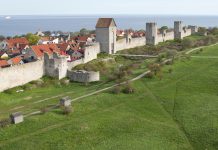

A dragon dance at the New York Chinese New Year. Via
Singapore
Singapore’s Chinatown, once home to the first Chinese settlers in what’s now a heavily Westernized city-state, is one of its few distinctly Asian neighborhoods.


The Grand Buddha Tooth Relic Temple in Singapore. Via
The enclave was home to the area’s earliest Chinese settlers. Several of its institutions, such as the Heritage Centre, Food Street, and Night Market, preserve the culture of its original inhabitants, while some areas of the district are designated national heritage sites.
Many historic buildings remain as relics of the past, as well as to complement the otherwise modern landscape.
Melbourne
Melbourne boasts the oldest Chinatown in the world, established during Victoria’s Gold Rush in 1854.


Via
Catch the world’s longest Chinese dragon– the Millennium Dai Loong Dragon tops 100 meters — in action as it is brought to life by 200 people during the Chinese New Year parade.
Kuala Lumpur
The capital of Malaysia was actually founded by Chinese tin prospectors in the 1850s, who played a pivotal role in the city’s transformation from a jungle settlement to a center for the tin mining industry. The Chinese remain the city’s dominant ethnic group and control a large proportion of the country’s commerce.


A flower-seller on Petaling Street. Via
Chinatown, known locally as Petaling Street or Jalan Petaling, is famous for its food stalls and night market, where shoppers can load up on fresh produce and counterfeit DVDs, watches and purses (don’t forget to haggle).
Georgetown, Penang, Malaysia
Arriving in Georgetown, Penang, off the west coast of Malaysia after a long journey from Thailand, you may almost think that you accidentally traveled all the way to China. The city’s Chinatown is one of the largest and best preserved in the world, with everyday sights and sounds reminiscent of a small city in China.


The Kuan Yin Teng Temple in Georgetown. Via
Most residents are descended from Chinese immigrants who arrived in Penang during the colonial era and made their fortunes as traders and shopkeepers. Many of their original shops are still intact today.
Toronto
In the most ethnically diverse city in the world, residents have their pick of seven Chinatowns. The city’s main Chinatown was formed in the late 1960s, when many businesses in the original Chinatown were forced to move.


Via
Since the 1980s, the Greater Toronto Area’s Chinese community has migrated to the suburbs of Scarborough, Mississauga, Richmond Hill, Markham, and North York, where shopping centers are reminiscent of Hong Kong’s malls and street stalls.
New York
New York’s first Chinese residents began arriving in Manhattan’s Lower East Side in the late 19th century to escape discriminatory measures on the West Coast. In the 1980s, the neighborhood eclipsed San Francisco’s as the largest Chinatown outside Asia.


A dragon dance at the New York Chinese New Year. Via
But don’t overlook the city’s other Chinese enclaves – in Elmhurst and Flushing in Queens, and along Avenue U and 8th Avenue in Brooklyn. In fact, Flushing’s Chinatown has now surpassed Manhattan’s in size.
Vancouver
There’s a reason this city has been nicknamed “Hongcouver.” In the years leading up to Hong Kong’s 1997 handover to China, waves of wealthy immigrants flooded the city. The mayor, Sam Sullivan, even speaks Cantonese.


Via.
Vancouver’s Chinatown dates back to the early 20th century, although recent arrivals have headed for the suburb of Richmond, where many of the Chinese restaurants are considered the best outside of Hong Kong.
San Francisco
The city’s Chinese New Year parade, an annual event since the 1860s, is the largest Asian cultural celebration outside of Asia. Chinatown may seem like a tacky tourist trap, but one cannot ignore the history and significance of one of the world’s best-known Chinese quarters, once the stomping grounds of Sun Yat-Sen and Amy Tan.


The Eastern Bakery in San Francisco’s Chinatown. Via.
The original enclave, built in the 1850s by settlers who had arrived during the gold rush and railroad days, would be the world’s oldest had it not been destroyed in the 1906 earthquake. Since the 1960s, much of the city’s Chinese community has moved into the Sunset and Richmond districts, while newer immigrants often settle in the suburbs around the Bay Area.
![]()

This piece was originally published on January 21, 2009.
Posted In:
Destinations:
Powered by WPeMatico











